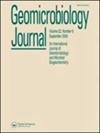化石骨骼降解的潜在环境驱动因素——两个喀尔巴阡洞穴的元条形码方法
IF 2.2
4区 环境科学与生态学
Q3 ENVIRONMENTAL SCIENCES
引用次数: 0
摘要
摘要对骨化石微生物群落的研究很少;对洞穴沉积物进行的研究更少。在我们的研究中,对沉积物和骨骼化石进行了采样,并对罗马尼亚一些最重要的考古和古生物遗址Muierilor和Ursilor洞穴的样本进行了基于16S rRNA基因的全群落代谢条形码分析。大多数已鉴定的分类群属于细菌,在两个洞穴的骨骼样本中,变形菌门、酸杆菌门、拟杆菌门和放线菌门是最丰富的门。沉积物样品的组成相似,变形杆菌门和不动杆菌门是最丰富的门。推断的菌群表明存在环境特异性细菌、典型的骨定植菌、土壤中发现的细菌、分解人类遗骸或考古剖面的细菌,以及溶解磷酸盐和有机营养细菌。多样性指数表明,Muierilor洞穴的骨骼样本的多样性高于Ursilor洞穴的样本和两个洞穴的沉积物样本。在解释不同洞穴环境中细菌组的多样性时,还考虑了环境条件,特别是空气相对湿度。这些发现有助于了解骨骼化石在各种环境条件下的沉积和降解。此外,这是首次尝试将微环境和细菌与保存洞穴中的骨骼化石联系起来。本文章由计算机程序翻译,如有差异,请以英文原文为准。
Potential Environmental Drivers of Fossil Bones Degradation—A Metabarcoding Approach in Two Carpathian Caves
Abstract Studies on fossil bone microbial communities are scarce; even fewer studies were performed in cave deposits. For our research, sediments and fossil bones were sampled, and the whole community 16S rRNA gene-based metabarcoding analyses were performed on samples from Muierilor and Ursilor caves, some of Romania’s most important archaeological and paleontological sites. Most of the identified taxa belong to Bacteria, with Proteobacteria, Acidobacteriota, Bacteroidota, and Actinobacteriota amongst the most abundant phyla in bone samples from both caves. The sediment samples presented similar composition, with Proteobacteria and Acidobacteriota being the most abundant phyla. The inferred bacteriomes indicated the presence of environment-specific bacteria, typical bone colonizers, and bacteria found in soils and decomposing human remains or archaeological profiles as well as phosphate-solubilizing and organotrophic bacteria. Diversity indices indicated a higher diversity in bone samples from Muierilor Cave than in Ursilor Cave samples and sediment samples from both caves. Environmental conditions, especially air relative humidity, were also considered in explaining the bacteriome diversity in different cave settings. These findings help to understand fossil bones’ deposition and degradation in various environmental conditions. Furthermore, this is the first attempt to relate microenvironments and bacteria to preserving fossil bones from caves.
求助全文
通过发布文献求助,成功后即可免费获取论文全文。
去求助
来源期刊

Geomicrobiology Journal
环境科学-地球科学综合
CiteScore
4.80
自引率
8.70%
发文量
70
审稿时长
3.3 months
期刊介绍:
Geomicrobiology Journal is a unified vehicle for research and review articles in geomicrobiology and microbial biogeochemistry. One or two special issues devoted to specific geomicrobiological topics are published each year. General articles deal with microbial transformations of geologically important minerals and elements, including those that occur in marine and freshwater environments, soils, mineral deposits and rock formations, and the environmental biogeochemical impact of these transformations. In this context, the functions of Bacteria and Archaea, yeasts, filamentous fungi, micro-algae, protists, and their viruses as geochemical agents are examined.
Articles may stress the nature of specific geologically important microorganisms and their activities, or the environmental and geological consequences of geomicrobiological activity.
The Journal covers an array of topics such as:
microbial weathering;
microbial roles in the formation and degradation of specific minerals;
mineralization of organic matter;
petroleum microbiology;
subsurface microbiology;
biofilm form and function, and other interfacial phenomena of geological importance;
biogeochemical cycling of elements;
isotopic fractionation;
paleomicrobiology.
Applied topics such as bioleaching microbiology, geomicrobiological prospecting, and groundwater pollution microbiology are addressed. New methods and techniques applied in geomicrobiological studies are also considered.
 求助内容:
求助内容: 应助结果提醒方式:
应助结果提醒方式:


